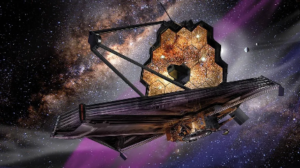Alien Life K2-18b: Webb Detects Biosignatures
Could alien life exist on a distant world? New research on alien life K2-18b brings us closer to that answer. Located 124 light-years away, this massive exoplanet may host signs of life, thanks to groundbreaking data from the James Webb Space Telescope.
Astronomers have identified two intriguing molecules—dimethyl sulfide (DMS) and dimethyl disulfide (DMDS)—in the planet’s atmosphere. These are compounds that, on Earth, are produced exclusively by living organisms. Their presence on K2-18b has ignited scientific excitement and global interest.
This discovery is part of a broader initiative to study exoplanets using advanced space-based telescopes. The detection of potential biosignatures is not just an astronomical milestone, but also a philosophical one. It challenges our view of life and opens the door to a universe where we may not be alone.
Biosignatures Detected on K2-18b
Professor Nikku Madhusudhan from the University of Cambridge, who led the study, described the finding as the strongest evidence yet for biological activity beyond our solar system. “The chemical signals were surprisingly strong,” he said. “This might be the first moment when alien life K2-18b truly entered our scientific framework.”
The James Webb Space Telescope, using its infrared capabilities, analyzed light from the planet’s star as it filtered through K2-18b’s atmosphere. The results revealed high concentrations of DMS and DMDS, far beyond what is seen naturally on Earth. The odds of a false positive are just 0.3%—making the data incredibly compelling.
The findings were published in The Astrophysical Journal Letters, adding further credibility to the results. The presence of these chemicals could point to oceans teeming with microbial life, buried beneath thick clouds of hydrogen and water vapor.
The Nature of K2-18b
Unlike rocky planets like Earth or Mars, K2-18b belongs to a class of planets called “Hycean worlds.” These planets are theorized to have deep oceans and thick hydrogen-rich atmospheres. This particular planet is nearly nine times Earth’s mass, with a stable orbit around a cool red dwarf in the habitable zone—where temperatures could allow for liquid water.
These conditions make it an exceptional candidate for studying the potential of life in extreme environments. “Alien life K2-18b is no longer just a theory—it’s a viable hypothesis,” said one researcher. “This is why we build telescopes like Webb.”

Skeptical Perspectives
Despite the enthusiasm, not all scientists are convinced. Some argue that these molecules might be the result of exotic chemical reactions unrelated to life. Volcanic activity, comet impacts, or unknown atmospheric processes could also create similar signatures.
Dr. Nora Hänni, who once detected DMS on a lifeless comet, urges caution. “Life is just one of many explanations,” she said. “We need more data before making such extraordinary claims.”
Dr. Jo Barstow added, “The burden of proof for alien life is enormous. We need multiple lines of evidence, not just one detection. That said, this is an incredible start.”
Scientific and Cultural Impact
The discovery has sparked renewed interest in astrobiology, planetary science, and the philosophical implications of extraterrestrial life. Public curiosity has surged, with the term “alien life K2-18b” trending on social media and featured in major science news outlets.
Agencies like NASA and ESA are now considering new missions and instruments that could further analyze this world. There’s also speculation that private space companies may turn their focus to Hycean planets in the coming decades.
Beyond the science, this moment represents a deeper human quest—to understand our place in the cosmos. Whether or not life is confirmed on K2-18b, the idea that we are not alone has moved from fiction to scientific plausibility.
The Road Ahead
Future observations with Webb and upcoming observatories like the European Extremely Large Telescope may provide more precise measurements. These instruments could detect additional biosignatures, or perhaps even determine the chemical processes happening on K2-18b’s surface and in its oceans.
For now, K2-18b stands as one of the most promising leads in the ongoing search for alien life. It serves as a reminder that the universe is far more complex and mysterious than we often imagine.







